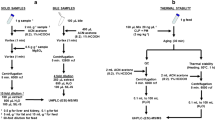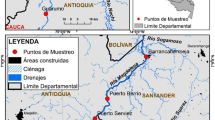Abstract
Pesticide residues in fish muscle are an environmental and a health safety concern which requires analytical methods presenting high sensitivity and low limits of quantification. In this study, adapted QuEChERS method, coupled to liquid chromatography tandem mass spectrometry (Scheduled MRM-5500 QTRAP), was developed to quantify 13 pesticides (azoxystrobin, clomazone, diflufenican, dimethachlor, carbendazim, iprodion, isoproturon, mesosulfuron-methyl, metazachlor, napropamid, quizalofop and thifensulfuron-methyl) in muscle of fish. Quantification limits were below 1 ng g−1 except for clomazone (1.8 ng g−1) and quizalofop (7.4 ng g−1). Best recoveries were observed for perch (>80%) and roach (>68%), except for thifensulfuron-methyl. Lower recoveries had been observed for carp (6% to 86%). Relative standard deviation was lower than 28% for intra-day and 29% for inter-day analysis, respectively. This method was successfully tested on three fish species, naturally or orally exposed: roach (Rutilus rutilus), perch (Perca fluviatilis) and carp (Cyprinus carpio). Few levels were observed in fish naturally exposed, but carp and perch orally contaminated showed measurable levels in their muscles.





Similar content being viewed by others
References
Reemtsma T, Jekel M (2006) Organic pollutants in the water cycle. Wiley-VCH Verlag GmBH & Co. KGaA, Weinheim
Loos R, Gawlik BM, Locoro G, Rimaviciute E, Contini S, Bidoglio G (2009) EU-wide survey of polar organic persistent pollutants in European river waters. Environ Pollut 157:561–568
Devault DA, Gérino M, Laplanche C, Julien F, Winterton P, Merlina G, Delmas F, Lim P, Miguel Sánchez-Pérez J, Pinelli E (2009) Herbicide accumulation and evolution in reservoir sediments. Sci Total Environ 407:2659–2665
Bony S, Gaillard I, Devaux A (2010) Genotoxicity assessment of two vineyard pesticides in zebrafish. Int J Environ Anal Chem 90:421–428
Marchand J, Tanguy A, Charrier G, Quiniou L, Plee-Gauthier E, Laroche J (2006) Molecular identification and expression of differentially regulated genes of the European flounder, Platichthys flesus, submitted to pesticide exposure. Mar Biotechnol 8:275–294
Gorbatiuk LO (2010) Physiological-biochemical response of fish to the pesticide effect (a review). Hydrobiol J 46:78–87
Hu G, Dai J, Mai B, Luo X, Cao H, Wang J, Li F, Xu M (2010) Concentrations and accumulation features of organochlorine pesticides in the Baiyangdian lake freshwater food web of North China. Arch Environ Contam Toxicol 58:700–710
John PJ, Prakash A (2003) Bioaccumulation of pesticides on some organs of freshwater catfish Mystus vittatus. Bull Environ Contam Toxicol 70:1013–1016
Sun F, Wong SS, Li GC, Chen SN (2006) A preliminary assessment of consumer's exposure to pesticide residues in fisheries products. Chemosphere 62:674–680
Malik AK, Blasco C, Picó Y (2010) Liquid chromatography-mass spectrometry in food safety. J Chromatogr A 1217:4018–4040
Reemtsma TJ (2003) Liquid chromatography-mass spectrometry and strategies for trace-level analysis of polar organic pollutants. J Chromatogr A 1000:477–501
Pico Y, Blasco C, Font G (2004) Environmental and food applications of LC-tandem mass spectrometry in pesticide-residue analysis: an overview. Mass Spectrom Rev 23:45–85
Alder L, Greulich K, Kempe G, Vieth B (2006) Residue analysis of 500 high priority pesticides: better by GC-MS or LC-MS/MS? Mass Spectrom Rev 25:838–865
Kuster M, Lopez de Alda MJ, Barcelo D (2006) Analysis of pesticides in water by liquid chromatography-tandem mass spectrometric techniques. Mass Spectrom Rev 25:900–916
Ferrer I, Thurman EM, Zweigenbaum JA (2007) Screening and confirmation of 100 pesticides in food samples by liquid chromatography/tandem mass spectrometry. Rapid Commun Mass Spectrom 21:3869–3882
Nardelli V, Dell'Oro D, Palermo C, Centonze D (2010) Multi-residue method for the determination of organochlorine pesticides in fish feed based on a cleanup approach followed by gas chromatography-triple quadrupole tandem mass spectrometry. J Chromatogr A 1217:4996–5003
Petrovic M, Farré M, De Alda ML, Perez S, Postigo C, Köck M, Radjenovic J, Gros M, Barcelo D (2010) Recent trends in the liquid chromatography-mass spectrometry analysis of organic contaminants in environmental samples. J Chromatogr A 1217:4004–4017
Rodil R, Quintana JB, López-Mahía P, Muniategui-Lorenzo S, Prada-Rodríguez D (2009) Multi-residue analytical method for the determination of emerging pollutants in water by solid-phase extraction and liquid chromatography-tandem mass spectrometry. J Chromatogr A 1216:2958–2969
Barrek S, Cren-Olivé C, Wiest L, Baudot R, Arnaudguilhem C, Grenier-Loustalot MF (2009) Multi-residue analysis and ultra-trace quantification of 36 priority substances from the European Water Framework Directive by GC-MS and LC-FLD-MS/MS in surface waters. Talanta 79:712–722
Baugros JB, Giroud B, Dessalces G, Grenier-Loustalot MF, Cren-Olivé C (2008) Multiresidue analytical methods for the ultra-trace quantification of 33 priority substances present in the list of REACH in real water samples. Anal Chim Acta 607:191–203
Pico Y, Barcelo D (2008) The expanding role of LC-MS in analyzing metabolites and degradation products of food contaminants. Trac Trends Anal Chem 27:821–835
Blasco C, Font G, Pico Y (2005) Analysis of pesticides in fruits by pressurized liquid extraction and liquid chromatography-ion trap-triple stage mass spectrometry. J Chromatogr A 1098:37–43
Anastassiades M, Lehotay SJ, Stajnbaher D, Schenck FJ (2003) Fast and easy multiresidue method employing acetonitrile extraction/partitioning and “dispersive solid phase extraction” for the determination of pesticides residues in produce. J AOAC Int 86:412–431
Wilkowska A, Biziuk M (2011) Determination of pesticide residues in food matrices using QuEChERS methodology. Food Chem 125:803–812
Kolberg DI, Prestes OD, Adaime MB, Zanella R (2011) Development of a fast multiresidue method for the determination of pesticides in dry samples (wheat grains, flour and bran) using QuEChERS based method and GC-MS. Food Chem 125:1426–1442
Chen G, Cao P, Liu R (2011) A multi-residue method for fast determination of pesticides in tea by ultra performance liquid chromatography-electrospray tandem mass spectrometry combined with modified QuEChERS sample preparation procedure. Food Chem 125:1406–1411
Gonzalez-Curbelo MA, Hernandez-Borges J, Ravelo-Perez LM (2011) Insecticides extraction from banana leaves using modified QuEChERS method. Food Chem 125:1083–1090
Rawn DFK, Judge J, Roscoe V (2010) Application of the QuEChERS mehod for the analysis of pyrethrins and pyrethroids in fish tissues. Anal Bioanal Chem 397:2525–2531
Lehotay SJ, Mastovska K, Yun SJ (2005) Evaluation of two fast and easy methods for pesticide residue analysis in fatty food matrices. J AOAC Int 88:630–638
Couteux A (2008) Index phytosanitaire. ACTA, Lille
Pang G-F, Cao Y-Z, Fan C-L, Jia G-Q, Zhang J-J, Li X-M, Liu Y-M, Shi Y-Q, Li Z-Y, Zheng F, Lian Y-J (2009) Analysis method study on 839 pesticide and chemical contaminant multiresidues in animal muscles by gel permeation chromatography cleanup, GC/MS, and LC/MS/MS. JAOAC Int 92:933–940
Council of European Communities (1986) Council Directive 86/609/EEC of 24 November 1986 on the approximation of laws, regulations and administrative provisions of the Member States regarding the protection of animals used for experimental and other scientific purposes. Available at http://europa.eu/legislation_summaries/environment/nature_and_biodiversity/l28104_en.htm
Aguilera-Luiz MM, Martinez Vidal JL, Romero-Gonzales R, Garrido Frenich A (2008) Multi-residue determination of veterinary drugs in milk by ultra-high-pessure liquid chromatography-tandem mass spectrometry. J Chromatogr A 1205:10–16
Przybylski C, Segard C (2009) Method for routine screening of pesticides and metabolites in meat based baby-food using extraction and gas chromatography-mass spectrometry. J Sep Sci 32:1858–1867
NF V03-061; NF EN 15662:2009-01-01 Foods of plant origin—determination of pesticide residues using GC-MS and/or LC-MS/MS following acetonitrile extraction/partitioning and clean-up by dispersive SPE-QuEChERS-method
Acknowledgments
This work was funded by the Agence de l'Eau Rhin-Meuse and the Zone Atelier Moselle, which are gratefully acknowledged.
Author information
Authors and Affiliations
Corresponding author
Rights and permissions
About this article
Cite this article
Lazartigues, A., Wiest, L., Baudot, R. et al. Multiresidue method to quantify pesticides in fish muscle by QuEChERS-based extraction and LC-MS/MS. Anal Bioanal Chem 400, 2185–2193 (2011). https://doi.org/10.1007/s00216-011-4945-z
Received:
Revised:
Accepted:
Published:
Issue Date:
DOI: https://doi.org/10.1007/s00216-011-4945-z




